Four Things That Matter
 Health matters. What did you do this year to take care of your physical health? What did you do this year to take care of your mental health? Next year what can you stop doing to make it easier to take care of your physical and mental health? Without your health, what do you have?
Health matters. What did you do this year to take care of your physical health? What did you do this year to take care of your mental health? Next year what can you stop doing to make it easier to take care of your physical and mental health? Without your health, what do you have?
Family matters. What did you do this year to connect more deeply with your family? And how do you feel about that? Next year what can you change to make it easier to deepen your relationships with a couple of family members? If you’re going to forgive anyone next year, why not forgive a family member? Without family, what do you have?
Friends matter. What did you do this year to reconnect with old friends? What did you do this year to help turn a good friendship into a great one? What did you do this year to make new friends? Next year what will make it easier to reestablish old friendships, deepen the good ones, and create new ones? Without friends, what do you have?
Fun matters. What did you do this year to have fun for fun’s sake? Why is it so difficult to have fun? Next year what can you change to make it easier for you to have more fun? Without fun, what do you have?
“Friendship” by *~Dawn~* is licensed under CC BY 2.0.
Reducing Time To Market vs. Improving Profits
 X: We need to decrease the time to market for our new products.
X: We need to decrease the time to market for our new products.
Me: So, you want to decrease the time it takes to go from an idea to a commercialized product?
X: Yes.
Me: Okay. That’s pretty easy. Here’s my idea. Put some new stickers on the old product and relaunch it. If we change the stickers every month, we can relaunch the product every month. That will reduce the time to market to one month. The metrics will go through the roof and you’ll get promoted.
X: That won’t work. The customers will see right through that and we won’t sell more products and we won’t make more money.
Me: You never said anything about making more money. You said you wanted to reduce the time to market.
X: We want to make more money by reducing time to market.
Me: Hmm. So, you think reducing time to market is the best way to make more money?
X: Yes. Everyone knows that.
Me: Everyone? That’s a lot of people.
X: Are you going to help us make more money by reducing time to market?
Me: I won’t help you with both. If you had to choose between making more money and reducing time to market, which would you choose?
X: Making money, of course.
Me: Well, then why did you start this whole thing by asking me for help improving time to market?
X: I thought it was the best way to make more money.
Me: Can we agree that if we focus on making more money, we have a good chance of making more money?
X: Yes.
Me: Okay. Good. Do you agree we make more money when more customers buy more products from us?
X: Everyone knows that.
Me: Maybe not everyone, but let’s not split hairs because we’re on a roll here. Do you agree we make more money when customers pay more for our products?
X: Of course.
Me: There you have it. All we have to do is get more customers to buy more products and pay a higher price.
X: And you think that will work better than reducing time to market?
Me: Yes.
X: And you know how to do it?
Me: Sure do. We create new products that solve our customers’ most important problems.
X: That’s totally different than reducing time to market.
Me: Thankfully, yes. And far more profitable.
X: Will that also reduce the time to market?
Me: I thought you said you’d choose to make more money over reducing time to market. Why do you ask?
X: Well, my bonus is contingent on reducing time to market.
Me: Listen, if the previous new product development projects took two years, and you reduce the time to market to one and half years, there’s no way for you to decrease time to market by the end of the year to meet your year-end metrics and get your bonus.
X: So, the metrics for my bonus are wrong?
Me: Right.
X: What should I do?
Me: Let’s work together to launch products that solve important customer problems.
X: And what about my bonus?
Me: Let’s not worry about the bonus. Let’s worry about solving important customer problems, and the bonuses will take care of themselves.
Image credit — Quinn Dombrowski
X: Me: format stolen from @swardley. Thank you, Simon.
Which new product development project should we do first?
 X: Of the pool of candidate new product development projects, which project should we do first?
X: Of the pool of candidate new product development projects, which project should we do first?
Me: Let’s do the one that makes us the most money.
X: Which project will make the most money?
Me: The one where the most customers buy the new product, pay a reasonable price, and feel good doing it.
X: And which one is that?
Me: The one that solves the most significant problem.
X: Oh, I know our company’s most significant problem. Let’s solve that one.
Me: No. Customers don’t care about our problems, they only care about their problems.
X: So, you’re saying we should solve the customers’ problem?
Me: Yes.
X: Are you sure?
Me: Yes.
X: We haven’t done that in the past. Why should we do it now?
Me: Have your previous projects generated revenue that met your expectations?
X: No, they’ve delivered less than we hoped.
Me: Well, that’s because there’s no place for hope in this game.
X: What do you mean?
Me: You can’t hope they’ll buy it. You need to know the customers’ problems and solve them.
X: Are you always like this?
Me: Only when it comes to customers and their problems.
image credit: Kyle Pearce
It’s not so easy to move manufacturing work back to the US.
I hear it’s a good idea to move manufacturing work back to the US.
Before getting into what it would take to move manufacturing work back to the US, I think it’s important to understand why manufacturing companies moved their work out of the US. Simply put, companies moved their work out of the US because their accounting systems told them they would make more money if they made their products in countries with lower labor costs. And now that labor costs have increased in these no longer “low-cost countries”, those same accounting systems think there’s more money to be made by bringing manufacturing back to the US.
At a low level of abstraction, manufacturing, as a word, is about making discrete parts like gears, fenders, and tires using machines like gear shapers, stamping machines, and injection molding machines. The cost of manufacturing the parts is defined by the cost of the raw material, the cost of the machines, the cost of energy to power the machines, the cost of the factory, and the cost of the people to run the machines. And then there’s assembly, which, as a word, is about putting those discrete parts together to make a higher-level product. Where manufacturing makes the gears, fenders, and tires, assembly puts them together to make a car. And the cost of assembly is defined by the cost of the factory, the cost of fixtures, and the cost of the people to assemble the parts into the product. And the cost of the finished product is the sum of the cost of making the parts (manufacturing) and the cost of putting them together (assembly).
It seems pretty straightforward to make more money by moving the manufacturing of discrete parts back to the US. All that has to happen is to find some empty factory space, buy new machines, land them in the factory, hire the people to run the machines, train them, source the raw material, hire the manufacturing experts to reinvent/automate the manufacturing process to reduce cycle time and reduce labor time and then give them six months to a year to do that deep manufacturing work. That’s quite a list because there’s little factory space available that’s ready to receive machines, the machines cost money, there are few people available to do manufacturing work, the cost to train them is high (and it takes time and there are no trained trainers). But the real hurdles are the deep work required to reinvent/automate the process and the lack of manufacturing experts to do that work. The question you should ask is – Why does the manufacturing process have to be reinvented/automated?
There’s a dirty little secret baked into the accounting systems’ calculations. The cost accounting says there can be no increased profit without reducing the time to make the parts and reducing the labor needed to make them. If the work is moved from country A to country B and the costs (cycle time, labor hours, labor rate) remain constant, the profit remains constant. Simply moving from country A to country B does nothing. Without the deep manufacturing work, profits don’t increase. And if your country doesn’t have the people with the right expertise, that deep manufacturing work cannot happen.
And the picture is similar for moving assembly work back to the US. All that has to happen is to find empty factory space, hire and train people to do the assembly work, reroute the supply chains to the new factory, redesign the product so it can be assembled with an automated assembly line, hire/train the people to redesign the product so it can be assembled in an automated way, design the new automated assembly process, build it, test it, hire/train the automated assembly experts to do that work, hire the people to support and run the automated assembly line, and pay for the multi-million-dollar automated assembly line. And the problems are similar. There’s not a lot of world-class factory space, there are few people available to run the automated assembly line, and the cost of the automated assembly line is significant. But the real problems are the lack of experts to redesign the product for automated assembly and the lack of expertise to design, build, and validate the assembly line. And here are the questions you should ask – Why do we need to automate the assembly process and why does the product have to be redesigned to do that?
It’s that dirty little secret rearing its ugly head again. The cost accounting says there can be no increased profit without reducing the labor to assemble the parts. make them. If the work is moved from country A to country B and the assembly costs (labor hours, labor rate) remain constant, the profit remains constant. Simply moving from country A to country B does nothing. Without deep design work (design for automated assembly) and ultra-deep automated assembly work, profits don’t increase. And if your country doesn’t have the people with the right expertise, that deep design and automated assembly work cannot happen.
If your company doesn’t have the time, money, and capability to reinvent/automate manufacturing processes, it’s a bad idea to move manufacturing work back to the US. It simply won’t work. Instead, find experts who can help you develop/secure the capability to reinvent/automate manufacturing processes to reduce the cost of manufacturing.
If your company doesn’t have the time, money, and capability to design products for automated assembly and to design, build, and validated automated assembly systems, it’s a bad idea to move assembly work back to the US. It, too, simply won’t work. Instead, partner with experts who know how to do that work so you can reduce the cost of assembly.
Short Lessons
 Show customers what’s possible. Then listen.
Show customers what’s possible. Then listen.
The best projects are small until they’re not.
Today’s location before tomorrow’s destination.
The best idea requires the least effort.
Ready, fire, aim is better than ready, aim, aim, aim.
Be certain about the uncertainty.
Do so you can discuss.
Put it on one page.
Fail often, but call it learning.
Current state before future state.
Say no now to say yes later.
Effectiveness over efficiency.
Finish one to start one.
Demonstrate before asking.
Sometimes slower is faster.
Build trust before you need it.
“Yin & Yang martini” by AMagill is licensed under CC BY 2.0.
Three Important Choices for New Product Development Projects
 Choose the right project. When you say yes to a new project, all the focus is on the incremental revenue the project will generate and none of the focus is on unrealized incremental revenue from the projects you said no to. Next time there’s a proposal to start a new project, ask the team to describe the two or three most compelling projects that they are asking the company to say no to. Grounding the go/no-go decision within the context of the most compelling projects will help you avoid the real backbreaker where you consume all your product development resources on something that scratches the wrong itch while you prevent those resources from creating something magical.
Choose the right project. When you say yes to a new project, all the focus is on the incremental revenue the project will generate and none of the focus is on unrealized incremental revenue from the projects you said no to. Next time there’s a proposal to start a new project, ask the team to describe the two or three most compelling projects that they are asking the company to say no to. Grounding the go/no-go decision within the context of the most compelling projects will help you avoid the real backbreaker where you consume all your product development resources on something that scratches the wrong itch while you prevent those resources from creating something magical.
Choose what to improve. Give your customers more of what you gave them last time unless what you gave them last time is good enough. Once goodness is good enough, giving customers more is bad business because your costs increase but their willingness to pay does not. Once your offering meets the customers’ needs in one area, lock it down and improve a different area.
Choose how to staff the projects. There is a strong temptation to run many projects in parallel. It’s almost like our objective is to maximize the number of active projects at the expense of completing them. Here’s the thing about projects – there is no partial credit for partially completed projects. Eight active projects that are eight (or eighty) percent complete generate zero revenue and have zero commercial value. For your most important project, staff it fully. Add resources until adding more resources would slow the project. Then, for your next most important project, repeat the process with your remaining resources. And once a project is completed, add those resources to the pool and start another project. This approach is especially powerful because it prioritizes finishing projects over starting them.
“Three Cows” by Sunfox is licensed under CC BY-SA 2.0.
What would you do differently if you believed in yourself more?
Belief in yourself manifests in your actions. What do your actions say about your belief in yourself?
Belief in yourself doesn’t mean everything will work out perfectly. It means that you’ll be okay regardless of how things turn out.
When you see someone that doesn’t believe in themselves, how do you feel? And what do you do?
And when that someone is you, how do you feel? And what do you do?
When someone believes in you more than you do, do you believe them?
You reach a critical threshold when your belief in yourself can withstand others’ judgment of you.
When you believe in yourself, you don’t define yourself by what others think of you.
When you love yourself more, you believe in yourself more.
If you had a stronger belief in yourself, what would you do differently?
Try this. Make a list of three things you’d do differently if you had a stronger belief in yourself. Then, find one of those special people that believe in you and show them your list. And whatever they say about your list, believe them.
Image credit — ajari
Speaking your truth is objective evidence you care.
 When you see something, do you care enough to say something?
When you see something, do you care enough to say something?
If you disagree, do you care enough to say it out loud?
When the emperor has no clothes, do you care enough to hand them a cover-up?
Cynicism is grounded in caring. Do you care enough to be cynical?
Agreement without truth is not agreement. Do you care enough to disagree?
Violation of the status quo creates conflict. Do you care enough to violate?
If you care, speak your truth.
“Great Grey Owl (Strix nebulosa)” by Bernard Spragg is marked with CC0 1.0.
The Power of Leaving a Problem Unsolved
 Nothing changes unless there’s a problem.
Nothing changes unless there’s a problem.
In fact, without a problem, there can be no solution.
One of the devious ways to solve your problem is to create conditions for others to think it’s their problem.
Shame on you if you try to get me to solve your problem.
And shame on me if I try to solve your problem.
The best way for the problem to find its rightful owner is to leave the problem unsolved.
But leaving the problem unsolved also increases the pressure on all the innocent non-owners that work near the problem.
Leaving the problem unsolved is like a game of chicken, where the person who flinches first loses.
No one can give you their problem without your consent, but that doesn’t mean they won’t try.
So, when someone tries to give you their problem, put your hands in your pockets.
Leaving the problem unsolved isn’t a sign of non-caring, it’s a sign of higher-level caring.
Leaving the problem unsolved is the only way to pressure the company into the higher-level (and unpleasant) organizational learning of who is not solving their own problems.
“Prepare for Squirting” by Wootang01 is licensed under CC BY-ND 2.0.
Radical Cost Reduction and Reinvented Supply Chains
 As geopolitical pressures rise, some countries that supply the parts that make up your products may become nonviable. What if there was a way to reinvent the supply chain and move it to more stable regions? And what if there was a way to guard against the use of child labor in the parts that make up your product? And what if there was a way to shorten your supply chain so it could respond faster? And what if there was a way to eliminate environmentally irresponsible materials from your supply chain?
As geopolitical pressures rise, some countries that supply the parts that make up your products may become nonviable. What if there was a way to reinvent the supply chain and move it to more stable regions? And what if there was a way to guard against the use of child labor in the parts that make up your product? And what if there was a way to shorten your supply chain so it could respond faster? And what if there was a way to eliminate environmentally irresponsible materials from your supply chain?
Our supply chains source parts from countries that are less than stable because the cost of the parts made in those countries is low. And child labor can creep into our supply chains because the cost of the parts made with child labor is low. And our supply chains are long because the countries that make parts with the lowest costs are far away. And our supply chains use environmentally irresponsible materials because those materials reduce the cost of the parts.
The thing with the supply chains is that the parts themselves govern the manufacturing processes and materials that can be used, they dictate the factories that can be used and they define the cost. Moving the same old parts to other regions of the world will do little more than increase the price of the parts. If we want to radically reduce cost and reinvent the supply chain, we’ve got to reinvent the parts.
There are methods that can achieve radical cost reduction and reinvent the supply chain, but they are little known. The heart of one such method is a functional model that fully describes all functional elements of the system and how they interact. After the model is complete, there is a straightforward, understandable, agreed-upon definition of how the product functions which the team uses to focus the go-forward design work. And to help them further, the method provides guidelines and suggestions to prioritize the work.
I think radical cost reduction and more robust supply chains are essential to a company’s future. And I am confident in the ability of the methods to deliver solid results. But what I don’t know is: Is the need for radical cost reduction strong enough to cause companies to adopt these methods?
“Zen” by g0upil is licensed under CC BY-SA 2.0.
What does work look like?
 What does work look like when you prioritize your happiness?
What does work look like when you prioritize your happiness?
When it’s announced that open positions will not be backfilled to meet the practical realities of a recession, you reduce the scope of your projects and push out their completion dates to match the reduction in resources. And the impact on your career? I don’t know, but the people that work for you and everyone else that knows how the work is done will move mountains for you.
Under the banner of standard work, you are given the same task as the one you just completed. Sure, you can do it efficiently and effectively, but if you do that same work one more time, your brain will fall off. So, instead of doing it yourself, you give the work to a lesser-experienced person who is worthy of investment and help them get the work done. They get to learn new skills and the work is done well because you keep them on the straight and narrow. And you get to be a teacher and create a future leader that the company will need in a couple of years. And the downside? The work takes a little longer, but so what.
What does work look like when you prioritize your health?
When an extra-early meeting is scheduled because everyone’s regular day is already fully booked with meetings, you decline the meeting so you can get the recommended amount of sleep recommended by the health professionals. And the negative consequences to your career progression? Well, that’s a choice for your company.
When you get home from work, you disconnect your phone from the company network so you won’t be distracted by work-related interruptions. Because you separated yourself from work, after dinner is cleaned up you can make a healthy lunch for tomorrow. If there’s some downside risk to your career, find another company to work for.
What does work look like when you prioritize your family?
When an extra-late meeting is scheduled because everyone’s regular day is already fully booked with meetings, you decline the meeting so you can cook dinner and eat with your family. The conversation with the kids is mundane and meaningful and ten years from now they’ll be better for it. And the negative consequences? None, because tomorrow morning you can read the minutes of the meeting.
When you’re on your yearly holiday with your family and your boss calls your cell phone to ask you to come back to work early to deal with an emergency, you don’t answer the call and let it go to voicemail. Then, when you get back to the office after vacation, you listen to the voicemail and check in with your boss. And because you didn’t pick up the call, someone else had greatness thrust upon them and developed into someone who can solve emergencies. Now there are two of you. And the downside? Well, I think that depends on your boss.
“Looking For Clues (188 / 365)” by somegeekintn is licensed under CC BY 2.0.


 Mike Shipulski
Mike Shipulski